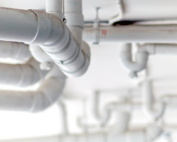The laundry room was typically located in the dark, dank recesses of an unfinished basement where one visited only to complete basic clothes cleaning activities. Today the laundry room has morphed into a kind of command hub where modern spaces house art studios, plant revival stations, and where all types of laundry-producing activities take place. The laundry room concept is on the move!
What It Is and What It Could Be
The laundry room was birthed on functionality with little attention given to design or creativity. Today’s laundries are enhanced with advanced technologies to make everyday life easier. Laundry appliances are becoming smarter, quieter, and multi-functioning as this space merges with other areas of the home. No longer afterthoughts, laundry rooms are turning into pet grooming centers, mail sorting stations, and mudrooms housing sporting equipment, pool supplies, and picnic gear. The dingy basement laundry area has exploded into a robust space offering users positive experiences alongside traditional clothes cleaning.
Where Should the Laundry Room Be Located?
Now that new life is being breasted into the laundry room there are options galore. One of the first decisions homeowners must make is to where they should move or locate a new laundry room. Both first and second-floor options are available, both carrying advantages and disadvantages. Here we will look at both choices in detail.
First Floor
First-floor laundry areas can be dedicated rooms or areas of rooms where necessary appliances are housed behind closed doors. They can be installed inside closets or tucked next to kitchen appliances as disguised by matching cabinetry. A first-floor laundry is a convenience as there is no need to trek to the basement.
Pros
The advantages of a first-floor laundry room are they can be installed near activities that create dirty laundry such as the kitchen. Gym bags can easily be emptied upon entering the home and pets can be washed after a run in the mud.
Another benefit to a first-floor laundry is plumbing from the kitchen or powder room can be ‘borrowed’ for use in the laundry, eliminating the need to install or relocate plumbing lines.
Cons
A downside to a first-floor laundry is that it eats up precious living space and can become a bottlenecked area as items accumulate blocking the natural flow of the room. Machines that are hidden in small spaces require proper venting to control moisture and these solutions are not always aesthetically pleasing.
Second Floor
Second-floor laundry rooms are becoming overwhelmingly popular as the space they use is less valuable and the convenience they add is irreplaceable. Here are the pros and cons of a second-floor laundry room.
Pros
Dirty clothing, sheets, and wet towels reside on the second floor so it only makes sense to bring the laundry room to them. Again, existing plumbing from a master or hall bath can accommodate the needs of the washing machine, and the time wasted hauling clothes up and down the steps is eliminated.
Cons
Noise is the #1 reason not to move the laundry room upstairs. Sleeping children or students concentrating on their studies can easily be distracted. Adding special insulation to the walls of the laundry can help along with reinforced flooring to cut back on vibrating washing machines.
Plumbing Requirements For Laundry Rooms
The heart of a well-functioning laundry room is the plumbing system. Without careful planning and consideration, a laundry room can quickly become a source of plumbing emergencies and health concerns for those who use the room.
There are three areas of plumbing that must be considered: the freshwater lines, the drainage system, and the ventilation of the dryer.
Freshwater Lines
Freshwater is needed to run the washing machine as well as supply clean water to the utility sink. This requires both a hot and a cold water line made from pipe materials that can withstand high temperatures. The hoses delivering water to the washer should be made of braided steel to ensure no leaking or flooding can occur. These hoses and the accompanying washers should be proactively replaced every 5 years and visually inspected yearly.
The same inspection process should be done on the sink supply lines and for any additional water features that may have been selected such as a dog spa. Always remember to insulate supply lines especially if the area is poorly insulated and poses a freezing threat to the water lines.
Drains
After the washer cycle is complete the dirty water must have a place to go. The drain acts as an exit pipe which includes a drain pipe connected to a standpipe, utility sink, or out the back wall. For second-floor laundry rooms, it is highly recommended you have a floor drain installed. This will drastically cut back on the chance of a flooding emergency.
Keeping the drain mechanism free of debris is an important job in the laundry room. A blocked drain can force the water emptying from the washer to spill out onto your floor creating a mess.
Ventilation
As mentioned earlier, a laundry area housed in a small space must be vented to reduce moisture accumulation and the possibility of mold growth. Even large laundry rooms require ventilation which can be supplied by installing a ventilation fan like those found in bathroom ceilings. The main goal is to reduce moisture and keep air flowing. A stand-alone dehumidifier can also be used.
Proper venting of the dryer is essential as well as using a rigid metal venting material. The vent should be insulated to avoid fires as it can become extremely hot. The best vent is one short in length so lint and debris can easily be cleared. Thus, positioning the dryer on an outside wall is preferable.
Need A Laundry Room Plumber In OC?
A properly located laundry room can become a real asset and make daily living easier and more enjoyable. There are unlimited design options available and each person’s ideal laundry will be different but all laundry rooms need to comply with proper plumbing installations so that the plumbing lines and ventilation features make for a safe and comfortable space.
Laundry rooms are growing into spaces that accommodate many more needs and activities than just washing and drying clothes. It will be fun to see how they keep changing and improving to reflect the lives of today’s busy families.
Contact our team of plumbing experts today! We can unclog washing machine drains, install gas lines for dryers, or help you with your water lines.

Slab Leaks: A True Plumbing Emergency
Home building following World War II was aggressive, so many houses were built on cement foundations to reduce the time it took to build them and to keep costs at a minimum. They were
How To Extend The Life Of Plumbing Pipes
A plumbing system consists of a complicated series of pipes, fixtures, and appliances that provide the infrastructure to run a well-functioning home. In this article, we will focus solely on plumbing pipes and ways
3 Silent Signs You Have A Plumbing Problem
Some plumbing issues announce themselves with a fury such as a drain backing up with sewage or a burst pipe, while others remain silent and destructive. In this article, we will reveal 3 signs



